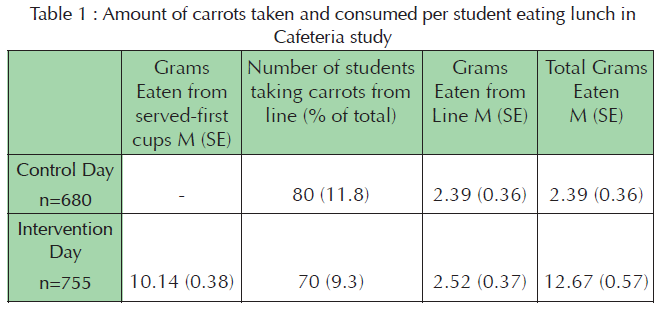How to increase vegetable intake among children?
It is well-known that having a healthy diet is essential to reduce the risk of suffering from many diseases like cancers, obesity, heart disease, etc.1-4 An overall healthy diet requires:
- limits on certain foods such as those high in calories, fat, sugar, or salt
- increasing the intake of healthy foods such as vegetables
Unfortunately, only 13% of the American population and less than 5% of children (9-13 years old) eat the daily recommended amount of vegetables5. Deciding what to eat often involves choosing among different possibilities. In this context, vegetables are typically much less attractive than tastier food on the same shelf, plate, or menu. This relative disadvantage poses a significant barrier to vegetable consumption: think about how hard it is to make a child eat carrots instead of candies when both are readily available.
Getting children to eat carrots and broccoli
We propose a simple solution to boost vegetable consumption: present vegetables first and far from all the other courses. This study was carried out in the cafeteria of an elementary school with approximately 800 students (5-11 years old). Children gathered in groups and went to the school’s cafeteria. After lining up, each child chose what they would eat for lunch. The results were convincing as the consumption of carrots and broccoli increased when they were presented in isolation and before the other foods.
How the order of serving foods has a positive impact on vegetable intake
Nothing changed on the control day; students chose and ate their lunch like every other day under “normal” conditions.
On the Vegetable-First day (3 months later), the same menu was presented to the students. Importantly, we also placed a small paper cup that contained two raw mini carrots (the same as those available from the line) on the table in front of each student upon arrival. Students could eat these carrots as they waited to enter the line, but they were never explicitly instructed or encouraged to eat them.
At the end of each lunch the mean amount of carrots eaten per student was calculated. We considered the amount of carrots eaten from served-first cups and from the serving line.
There was an increase in their carrots consumption by over 430% in the Vegetable-First day versus the control day (2.39g to 12.67g) – cf Table 1. This increase was almost entirely driven by many students eating carrots from the cups before entering the line.

The same methodology has also been used in the same elementary school on approximately 500 students. This time the vegetable used was broccoli and it was distributed while students stood in the register line (again with no encouragement to eat them). This experiment included an initial control day, repeated vegetables first interventions on three days, and a follow-up control day eight weeks later.
The long-term effects of the intervention
Results confirmed that serving a vegetable before other foods and in isolation increased its consumption in an elementary school cafeteria. They suggest that our intervention could be effective across a wide range of vegetables and this procedure should be fairly easy to implement in almost any school cafeteria. Furthermore, we examined the long-term effects of our intervention. In particular, we proved that the effectiveness of our intervention was the same, even with repeated exposures. This indicates that novelty was not the main explanation for our effects. We also noticed that our intervention had few lingering effects once removed.
Easy ideas to increase the consumption of vegetables
Future work should test our simple intervention across a range of settings, considering the high effectiveness and its relatively low implementation cost. This should include cafeterias with a range of mealtime procedures so that our intervention can apply as widely as possible. Although the logistics of serving vegetables first may be particularly challenging to commercial food service establishments, we firmly believe that eating vegetables first in isolation can prove useful to children, dieters, parents, school officials, and public policy makers. Parents, for example, might increase vegetable consumption by simply serving vegetables as an appetizer before serving the rest of the meal. Future research could also test whether our intervention encourages the development of healthier eating habits.
Based on: Redden JP, Mann T, Vickers Z, Mykerezi E, Reicks M, Elsbernd S (2015) Serving First in Isolation Increases Vegetable Intake among Elementary Schoolchildren. PLoS ONE 10(4): e0121283. doi:10.1371/journal.pone.01
References
- Tande DL, Magel R, Strand BN. Healthy Eating Index and abdominal obesity. Public Health Nutrition 2010; 13(02): 208–214. 2.
- Gao SK, Beresford SA, Frank LL, Schreiner PJ, Burke GL, Fitzpatrick AL. Modifications to the Healthy Eating Index and Its Ability to Predict Obesity: the Multi-Ethnic Study of Atherosclerosis. The American Journal of Clinical Nutrition 2008; 88(1): 64–69.
- Reedy J, Krebs-Smith SM, Miller PE, Liese AD, Kahle LL, Park Y, et al. Higher Diet Quality Is Associated with Decreased Risk of All-Cause, Cardiovascular Disease, and Cancer Mortality among Older Adults. The Journal of Nutrition 2014; 144(6): 881–889.
- Kant AK, Graubard BI. A Comparison of Three Dietary Pattern Indexes for Predicting Biomarkers of Diet and Disease. Journal of the American College of Nutrition 2005; 24(4): 294–303. PMID: 16093407
- Krebs-Smith SM, Guenther PM, Subar AF, Kirkpatrick SI, Dodd KW. Americans Do Not Meet Federal Dietary Recommendations. The Journal of Nutrition 2010; 140(10): 1832–1838.
